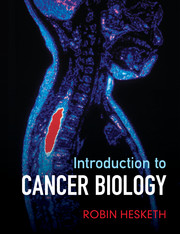Book contents
- Frontmatter
- Contents
- Acknowledgements
- Foreword
- Introduction
- 1 Lessons from epidemiology
- 2 Causes of cancer
- 3 Signalling in normal cells
- 4 ‘Cancer genes’: mutations and cancer development
- 5 What is a tumour?
- 6 Cancer signalling networks
- 7 The future of cancer prevention, diagnosis and treatment
- 8 The future of cancer in the post-genomic era
- Appendix A Tumour grading and staging
- Appendix B Targets of specific anti-cancer drugs
- Appendix C Classes of major oncoproteins
- Appendix D Major tumour suppressor genes
- Appendix E Ten major cancers at a glance
- Glossary and abbreviations
- Bibliography
- Index
- Plate Section
6 - Cancer signalling networks
Published online by Cambridge University Press: 05 February 2013
- Frontmatter
- Contents
- Acknowledgements
- Foreword
- Introduction
- 1 Lessons from epidemiology
- 2 Causes of cancer
- 3 Signalling in normal cells
- 4 ‘Cancer genes’: mutations and cancer development
- 5 What is a tumour?
- 6 Cancer signalling networks
- 7 The future of cancer prevention, diagnosis and treatment
- 8 The future of cancer in the post-genomic era
- Appendix A Tumour grading and staging
- Appendix B Targets of specific anti-cancer drugs
- Appendix C Classes of major oncoproteins
- Appendix D Major tumour suppressor genes
- Appendix E Ten major cancers at a glance
- Glossary and abbreviations
- Bibliography
- Index
- Plate Section
Summary
The major ‘drivers’ of cancer development arise in pathways from receptor tyrosine kinases that ultimately control cell division. Thus, for example, aberrant activity of the RAS-MAPK pathway occurs frequently across a broad spectrum of cancer types. However, cancer-promoting mutations occur in other signalling pathways and, as we have seen, all aspects of cellular behaviour are ultimately affected. The molecular details of most of these pathways and how they can be subverted in cancers are now well established. The integration between diverse pathways creates a picture of a complex ‘information network’ rather than of discrete, linear systems. Despite the multiplicity of signalling pathways that can be involved, the tumour cells that emerge as the result of appropriate groups of mutations are phenotypically similar in that they share the characteristics discussed in the previous chapter. This suggests that the diverse pathways converge on a ‘central axis’ and in this chapter we’ll look first at the central defenders that do indeed constitute the heart of our protection mechanisms against cancer. We’ll then overlay the major pathways from receptor to nucleus to show how they impact on the central axis and then dissect from that complex map each of the pathways in turn to introduce the key players. The intention is not to show all known detail but to convey the principal features of the pathways with particular emphasis on identified (proto-)oncogenes and tumour suppressors.
Introduction
When we began this review of cancer cell and molecular biology back in Chapter 3 we focused on one pathway along which information is transmitted from membrane to nucleus. That was the RAS-MAPK pathway and we considered in some detail how the proteins in that signal relay talk to each other. In the following chapter we looked at the effects of the major oncogenic mutations that can affect that pathway, which, because it essentially regulates the cell cycle, have the effect of uncoupling cell proliferation from its normal controls. One other critical control on cell division is provided by the braking effect of tumour suppressors in the cell cycle, the loss of function of these being examples of the other main category of ‘cancer mutation’.
- Type
- Chapter
- Information
- Introduction to Cancer Biology , pp. 153 - 178Publisher: Cambridge University PressPrint publication year: 2012



